The Razer Blade 14 (2023) Laptop Review: Ryzen 9 7940HS Tested With GeForce RTX 4070 Graphics
by Gavin Bonshor on June 20, 2023 11:00 AM ESTRazer Blade 14 (2023): System & Storage Performance
To add a little more flavor to data comparison, we've also included a couple of AMD Ryzen 7000 series desktop processors, including the Ryzen 7 7700 (8C/16T) and Ryzen 5 7600 (6C/12T) processors, which both have a TDP of 65 W. Using the same core architecture, these are obvious data points to consider, especially given it's a lower powered laptop part versus more generous desktop parts.
For all of the desktop chips within this comparison, as we expand our list of notebooks tested, we'll have more effective and comparable data points in the future.
Power
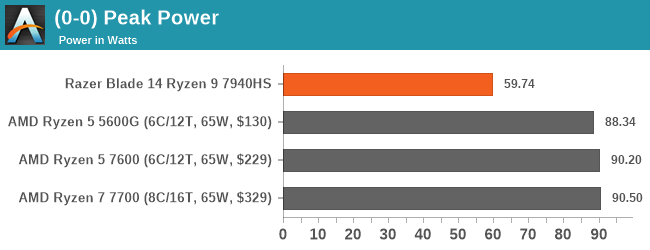
As this is the first time we've encountered AMD's Ryzen 9 7940HS mobile processor, we also wanted to look at power. As Razer has implemented the Ryzen 9 7940HS with a maximum of 54 W of the cTDP, which is available between 35 - 54 W, we can see that the chip in intensive workloads has a maximum package power draw of 59.7 W. Compared to the desktop chips, and with a lower TDP rating, the Ryzen 9 7940HS at 54 W draw not much more than the official TDP specifications provided by AMD.
Web & Office
The next section of our updated notebook test suite is web and office-based tests. Our updated notebook suite runs in parallel with our current CPU test suite for 2023. It allows us to blend mobile chips tested with desktop chips, mainly to see efficiency and performance levels and how they stack up for each generation we try.
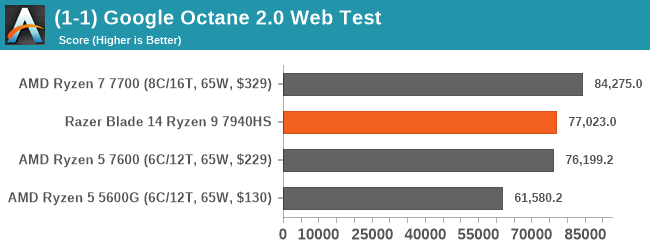
In our Chromium-based Google Octane 2.0 web test, the combination of the Razer Blade 14 and the AMD Ryzen 7940HS performed very well, especially compared to the desktop test bench with AMD's Ryzen 7 7700 (8C/16T) processor. The Ryzen 9 7940HS (54 W) performed 8% lower than the Ryzen 7 7700 (65 W), which is impressive when comparing a mobile chip to a desktop one.
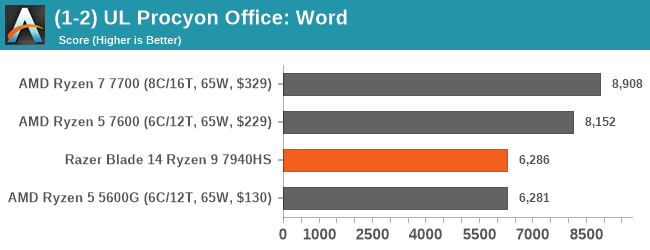
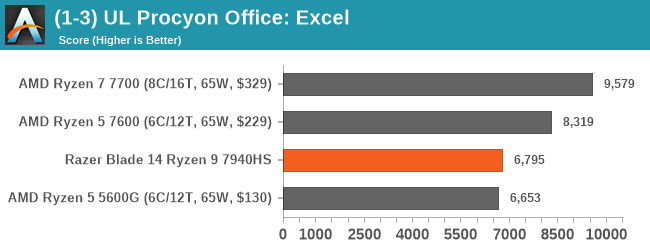
Using the UL Procyon Office-based suite with Microsoft Office 365 to measure office productivity performance, the Ryzen 9 7940HS, along with the Razer Blade 14 and its configuration, performed as well as expected. There are always trade-offs between desktop performance and a notebook operating as a desktop replacement, and the Razer Blade 14 (2023) does very well considering this.
Storage
Storage performance is dictated by more than just putting in the fastest drive you can; other variables include the interface used, the quality of the controller, and the overall drive. The sampled Razer Blade 14 we received had Samsung's MZVL21T0HCLR (PM9A1) 1 TB PCIe 4.0 x4 M.2 SSD. While Razer lists the specifications as a standard PCIe 4.0 x4 1 TB M.2 drive, a different drive could be replaced later in the production life cycle. Still, as this is what we have to work with, this is what we will be judging the Razer Blade 14's storage performance on.
The official specifications of the Samsung PM9A1 1 TB PCIe 4.0 x4 M.2 drive state expected sequential read speeds of up to 7000 MB/s, with sequential write speeds of up to 5100 MB/s. As we can see from a quick test using CrystalDiskMark 7.0.0, the expected raw throughput performance isn't far off the mark. Depending on whether the data is compressed or uncompressed, there's always an overlap and raw benchmark data varies.
When judging and measuring storage performance, it comes down to real-world performance and ensuring optimal cooling, especially on these fast NVMe drives, which can run very hot and thermally throttle, reducing performance.



Using the built-in storage benchmark within the PCMark 10 test suite, the performance displayed by the Razer Blade 14 (2023) with its 1 TB Samsung PCIe 4.0 x4 M.2 drive does look very good. As we test more notebooks soon, we'll have more comparative data points, but on first look, the storage performance on offer from the Blade 14 is precisely what we would expect from a PCIe 4.0 x4 M.2 drive.


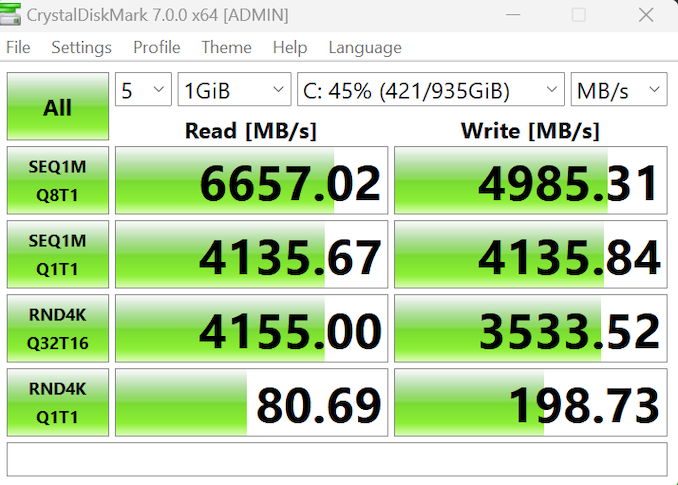








32 Comments
View All Comments
alphaod - Saturday, June 24, 2023 - link
Review is interesting. I agree with some of the comments here there seems to a sparse comparison to other gaming laptops, even if the previous generations would be kind of nice. For example, I own the 2021 model with the 5900HX & 3080 combo, so knowing how this compares would nice comparison.If I had to offer an opinion... I don't know anyone that really cares about productivity (Office) benchmarks nor SSD speeds. Most, if not all, major brand SSDs are basically the same bread and butter these days. Let's be real, nobody shopping for a laptop to do Excel's going to check benchmarks for it. They would care more about screen readability (do I need to clean it a lot or can I neglect it a little still see what I'm doing), how the keyboard and trackpad feels (is the spacing good or does the trackpad work well), is the webcam any good in different lightning for video calls. Is the login process easy like a fingerprint reader or IR camera. Does Windows Hello properly? On my 2021 model all these answers are they are excellent except the trackpad is hard to use when you need click and drag stuff; I use mine for work; a professional review should address these for productivity instead of nonsensical productivity benchmarks.
obed51815 - Thursday, July 20, 2023 - link
Thanks for sharing this post. It's fascinating to see how Razer has continuously evolved its Blade series over the years, offering various configurations to cater to different user preferences. The inclusion of AMD's Ryzen 9 7940HS processor with its powerful Zen 4 cores and integrated RDNA 3 GPU sounds promising for performance. Additionally, the option for either the GeForce RTX 4060 or RTX 4070 Laptop GPU adds flexibility to the lineup.It's impressive how AMD's Ryzen processors have reshaped the premium gaming laptop market, bringing healthy competition and more choices for consumers. This competition has undoubtedly driven both AMD and Intel to push the boundaries in terms of efficiency, performance, and affordability. As a potential buyer, it's essential to carefully consider the different configurations available and find the one that best suits individual needs and budget.
Ultimately, the Razer Blade 14 (2023) seems like a compelling option for gamers and power users alike, especially with its combination of Ryzen processing power and NVIDIA's latest mobile GPU technology. When making a decision, it's always a good idea to research and compare benchmarks to ensure it meets specific performance requirements. Happy gaming!